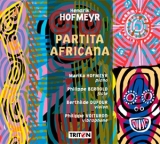 Hendrik Hofmeyr: Ballata africana op. 126 + Sonate für Flöte und Klavier op. 99 + Endymion and the Moon op. 113a + Partita africana op. 95 + Philomela’s Night Song op. 78a + Sonate für Vibraphon und Klavier et piano op. 206; Marika Hofmeyr, Klavier, Philippe Bernold, Flöte, Berthilde Dufour, Violine, Philippe Voituron, Vibraphon; 1 CD Triton TRIHORT574; Aufnahme 2020, Veröffentlichung 01/2021 (78'00) – Rezension von Remy Franck
Hendrik Hofmeyr: Ballata africana op. 126 + Sonate für Flöte und Klavier op. 99 + Endymion and the Moon op. 113a + Partita africana op. 95 + Philomela’s Night Song op. 78a + Sonate für Vibraphon und Klavier et piano op. 206; Marika Hofmeyr, Klavier, Philippe Bernold, Flöte, Berthilde Dufour, Violine, Philippe Voituron, Vibraphon; 1 CD Triton TRIHORT574; Aufnahme 2020, Veröffentlichung 01/2021 (78'00) – Rezension von Remy Franck
Triton veröffentlicht eine monographische CD, die dem südafrikanischen Komponisten Hendrik Hofmeyr (*1957) gewidmet ist. Hofmeyr gewann 1997 zwei große internationale Kompositionswettbewerbe, den Königin-Elisabeth-Musikwettbewerb in Belgien (mit ‘Raptus’ für Violine und Orchester) und den Dimitri Mitropoulos Wettbewerb in Athen (mit ‘Byzantium’ für Stimme und Orchester). Sein Oeuvre umfasst 6 Opern, 2 Ballette, 11 Konzerte und andere Orchesterwerke, 2 Streichquartette, weitere Kammer- und Instrumentalwerke sowie viele Chor- und Solo-Gesangswerke.
Hofmeyrs Musik ist getränkt von südafrikanischen Elementen: Landschaften, Legenden, Tänze und Musik der Ureinwohner. Der Komponist geht mit diesen Elementen sehr sensibel um, nicht archaisch, nicht effekthascherisch, sondern anreichernd und oft auch nachdenklich. Die Vermischung mit westlichen klassischen Formen ergibt sehr schöne, manchmal mysteriöse Stimmungen, die in den eloquenten und musikalisch tadellosen Interpretationen dieser CD sehr attraktiv werden.
Triton releases a monographic CD dedicated to the South African composer Hendrik Hofmeyr (b. 1957). Hofmeyr won two major international composition competitions in 1997, the Queen Elisabeth Music Competition in Belgium (with ‘Raptus’ for violin and orchestra) and the Dimitri Mitropoulos Competition in Athens (with ‘Byzantium’ for voice and orchestra). His oeuvre includes 6 operas, 2 ballets, 11 concertos and other orchestral works, 2 string quartets, other chamber and instrumental works, and many choral and solo vocal works.
Hofmeyr’s music is imbued with South African elements: Landscapes, legends, dances, and indigenous music. He handles these elements very sensitively. His music is not archaic, not gimmicky, but enriching and often thoughtful. The blending with Western classical forms results in very beautiful, sometimes mysterious moods, which become very attractive in the eloquent and musically impeccable interpretations of this CD.
























